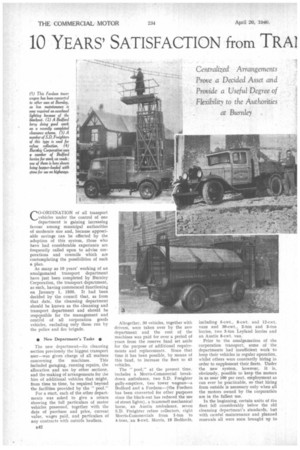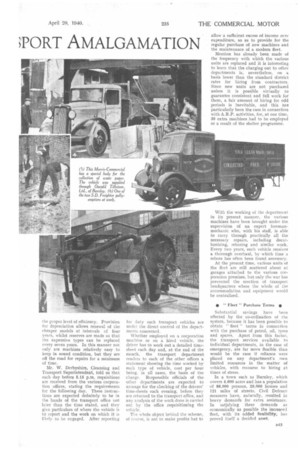10 YEARS' SATISFACTION from TRA1
Page 60

Page 61

If you've noticed an error in this article please click here to report it so we can fix it.
TORT AMALGAMATION
Centralized Arrangements Prove a Decided Asset and Provide a Useful Degree of Flexibility to the Authorities
at Burnley
CO-ORDINATION of all transport vehicles under the control of one department is gaining increasing favour among municipal authorities of moderate size and, because appreciable savings can be effected by the adoption of this system, those who have had considerable experience are frequently called upon to advise corporations and councils which are contemplating the possibilities of such a plan.
As many as 10 years' working of an amalgamated transport department have just been completed by Burnley Corporation, the transport department, as such, having commenced functioning on January 1, 1930. It had been decided by the council that, as from that date, the cleansing department should be known as the cleansing and transport department and should be responsible for the management and control of all corporation goods vehicles, excluding only those run by the police and fire brigade.
• New Department's Tasks •
The new department—its cleansing section previously the biggest transport user—was given charge of all matters concerning the machines. This included garaging, running repairs, the allocation and use by other sections, and the making of arrangements for the hire of additional vehicles that might, from time to time, be required beyond the facilities provided by the " pool."
For a start, each of the other departments was asked to give a return showing the full particulars of motor vehicles possessed, together with the date of purchase and price, current value, wages paid, and particulars of any contracts with outside hauliers. Altogether, 30 vehicles, together with drivers', were taken over by the new department and the cost of the machines was paid for over a period of years from the reserve fund set aside for the purpose of additional requirements and replacements. Since that time it has been possible, by means of this fund, to increase the fleet to 45 vehicles.
The " pool," at the present time, includes a Morris-Commercial breakdown ambulance, two S.D. Freighter gully-emptiers, two tower wagons—a Bedford and a Fordson—(the Fordson has been converted for other purposes since the black-out has reduced the use of street lights), a Scammell mechanical horse, an Austin ambulance, seven S.D. Freighter refuse collectors, eight Morris-Commercials from 1-ton to 4-tons, an 8-cwt. Morris, 19 Bedfords, including 5-cwt., 8-cwt. and 12-cwt. vans and 30-cwt., 2-ton and 3-ton lorries, two 3-ton Leyland lorries and an Austin 8-cwt. van.
Prior to the amalgamation of the corporation transport, some of the departments had insufficient work to keep their vehicles in regular operation, whilst others were constantly hiring in order to supplement their fleets. Under the new system, however, it is, obviously, possible to keep the motors in as near 100 per cent, employment as can ever be practicable, so that hiring from outside is necessary only when all the motors owned by the corporation are in the fullest use.
In the beginning, certain units of the fleet fell considerably below the old cleansing department's standards, but with careful maintenance and planned renewals all were soon brought up to the proper level of efficiency. Provision for depreciation allows renewal of the cheaper models at intervals of four years, whilst reserves are made so that the expensive types can be replaced every seven years. In this manner not only are machines relatively easy to keep in sound condition, but they arc all the road for repairs for a minimum of time.
Mr. W. Derbyshire, Cleansing and Transport Superintendent, told us that each day before 5.15 p.m. requisitions are received from the various corporation offices, stating the requirements for the following day. These instructions are expected definitely to be in the hands of the transport office not later than the time stated, and they give particulars of where the vehicle is to report and the work on which it is likely to be engaged. After reporting for duty such transport vehicles are under the direct control of the departments concerned.
Whether employed on a corporation machine or on a hired vehicle, the driver has to work out a detailed timesheet each day and, at the end of the month, the transport department renders to each of the other offices a statement showing the time worked by each type of vehicle, cost per hour being, in all cases, the basis of the charge. Responsible officials of the other departments are expected to arrange for the checking of the drivers' time-sheets each evening, before they are returned to the transport office, and any analysis of the work done is carried out by the office requisitioning the vehicle.
The whole object behind the scheme, of course, is not to make profits hut to allow a sufficient excess of income over expenditure, so as to provide for. the regular purchase of new machines and the maintenance of a modern fleet.
Mention has already been made of the frequency with which the various units are replaced and it is interesting to learn that the charging out to other departments is, nevertheless, on a basis lower than the standard district rates for hiring from contractors. Since new units are not purchased unless it is possible virtually to guarantee consistent and full work for them, a fair amount of hiring for odd periods is inevitable, and this has particularly been the case in connection with A.R.P. activities, for, at one time, 30 extra machines had to be employed as a result of the shelter programme.
With the working of the department in its present manner, the various machines have been brought under the supervision of an expert foremanmechanic who, with his staff, is able to carry through practically all the necessary repairs, including decarbonizing, reboring and similar work. Every two years, each vehicle receives a thorough overhaul, by which time a rebore has often been found necessary.
At the present time, various units of he fleet are still scattered about at garages attached to the various corporation premises, but only the war has prevented the erection of transport headquarters where the whole of Le accommodation and equipment would be centralized.
• " Fleet " Purchase Terms • Substantial savings have been effected by the co-ordination of the system, because it has been possible to obtain " fleet " terms in connection with the purchase of petrol, oil, tyres and spares. Apart from this factor, the transport services available to individual departments, in the case of emergency, are far more flexible than would he the case if reliance were placed on any department's own limited resources in the matter of vehicles, with recourse to hiring at times of stress.
In a town such as Burnley, which covers 4,600 acres and has a population of 88,000 persons, 26,000 houses and 121 miles of streets, Civil Defence measures have, naturally, resulted in heavy demands for extra assistance, In satisfying these demands as economically as possible the increased fleet, with its added flexibility, bas proved itself a decided asset.




































































































